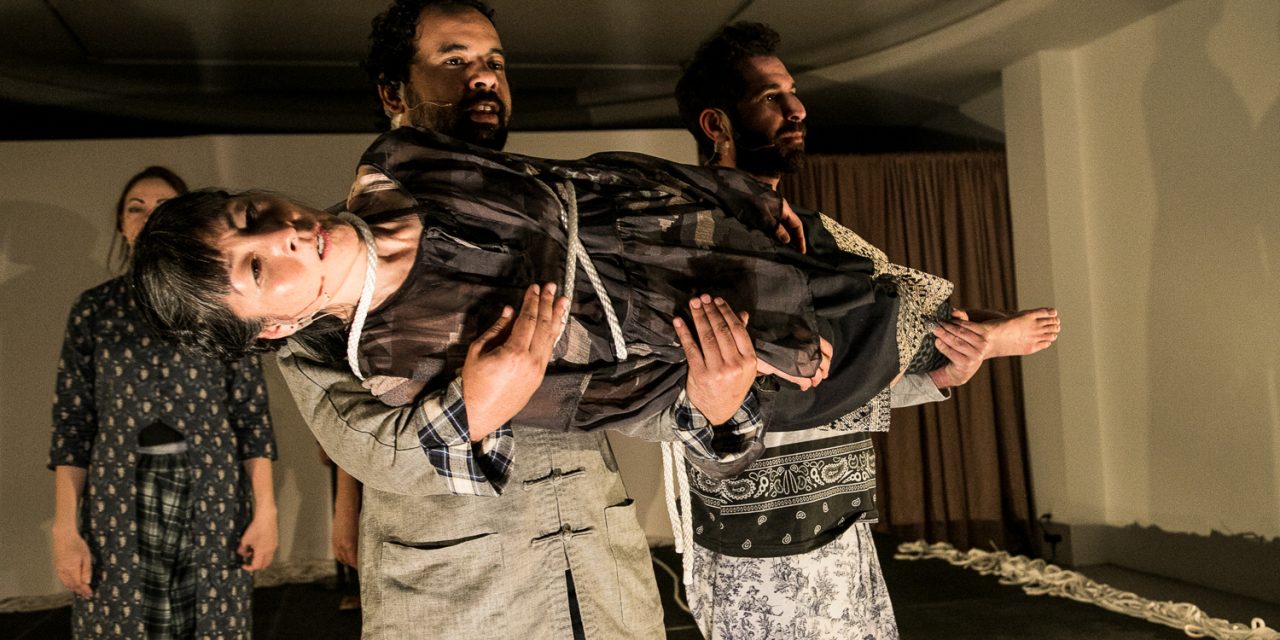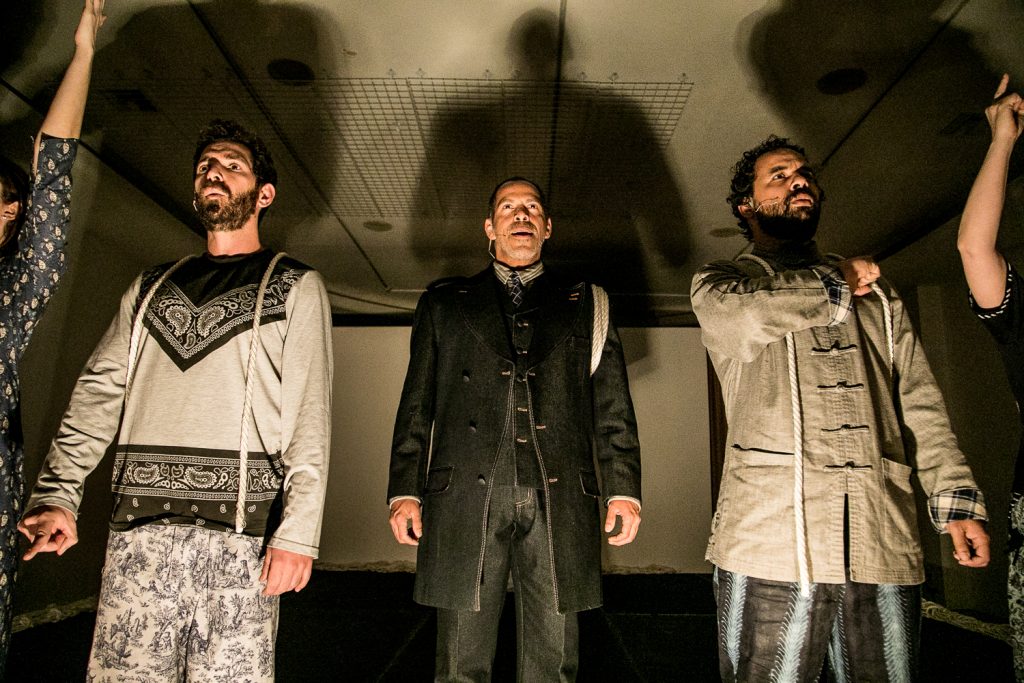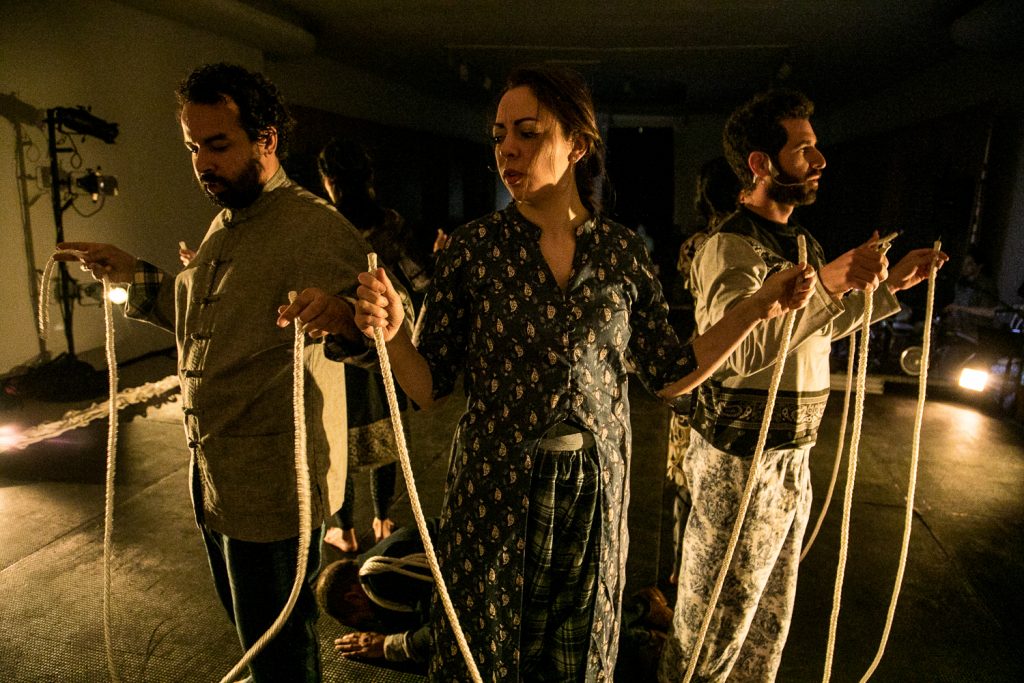The Theatre Dybbuk is based in Los Angeles and it presents powerful and powerfully performed productions based on Jewish history, folklore and rituals. Their current production that premiered at LACE (Los Angeles Contemporary Exhibitions) and that I attended this past weekend at the Dortort Center for Creativity in the Arts at UCLA Hillel, is called Lost Tribes, written and directed by Aaron Henne. It is truly absorbing work that utilized simple props and movement to voice a very poignant message of mankind’s inhumanity to itself.
The evening began in the center’s wide, third floor corridor with 8 actors dressed in varying traditional fabrics. Each person was placed behind what resembled small roped off areas in museums. The ropes were later utilized in a myriad of ways during the production. A repetitive speech came over the speaker informing us that these people represented the 9th Century BCE (Before Common Era) lost tribes of the Northern Kingdom of Israel. The ten lost tribes were the ten of the twelve tribes of ancient Israel that were said to have been deported from the Kingdom of Israel after its conquest by the Neo-Assyrian Empire circa 722 BCE. These are the tribes of Reuben, Simeon, Dan, Naphtali, Gad, Asher, Issachar, Zebulun, Manasseh and Ephraim.
We were instructed to pay special attention to what they were wearing and to their actions, as these were symbols of their tribal affiliations, family histories and daily practices. These were the descendants of the sons of Jacob and the voice told us to notice that they lived “side by side in harmony, knowing their places.” As in some museums, there were headphones place in between each actor with a recording of them speaking about their lineage or in one case, approximately two minutes of music.
On cue by musician Etienne Rivera Cabello, the actors move through the audience speaking to people about their family history. The voice of the Narrator, performed with intensity and strength by Joshua Wolf Coleman, then summons the audience into the performance area with the words, “Follow me. I will lead you to a safer place.”
Aaron Henne has written a play that weaves through Jewish history and then crashes into our current reality with shocking revelations on how repeatedly throughout the history of mankind, the inhabitants of one country or region has tried to annihilate, suppress or control the weaker population of other countries or differing cultures.
The actors tell the histories of their tribes through each BCE era, using their aforementioned pieces of rope as borders, routes through territories and shackles. The ropes are joined to symbolize tribal unity and then destroyed one link at a time as conflict separates peoples. Choreographer Kai Hazelwood has created wonderfully simple movement to portray the many emotions these people go through and the hardships that they endure.
The method that Henne uses to enter the present time came as a surprise to me. He moves out of Jewish history to assimilate modern humankind. These are wonderful actors and musicians who held my attention for the full evening without intermission. At one time I found myself on the edge of wanting the performance to be over, when Henne’s play dropped reality into my lap, drew me back in and caused me to say to myself, I did not see that coming!
Bravo to Aaron Henne and to the cast of actors and musicians of Theatre Dybbuk. They were Etienne Rivera Cabello, Joshua Wolf Coleman*, Nick Greene, Julie A. Lockhart*, Rebecca Rasmussen*, Angela Sauer*, Diana Tanaka*, Jonathan CK Williams*. The actors with asterisks appeared through the courtesy of Actors’ Equity Association.
The stark but dynamic lighting was designed by Brandon Baruch. The other talented designers not mentioned before included: Costumes by Kathryn Poppen; Composer, Michael Skloff in collaboration with Emilia Moscoso and Alex Shaw; Sound, Martin Carrillo, Production, Leslie K. Gray; and Dramaturg, Dylan Southard.
If Lost Tribes is appearing near you, I strongly recommend that you go see it. The production is currently touring to venues throughout southern California. For more information, click here.
Feature photo by Taso Papadakis.
To view the LA Dance Chronicle Calendar of Performances, click here.











